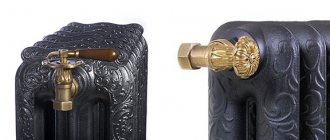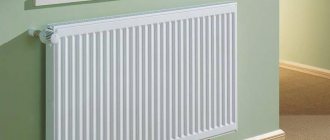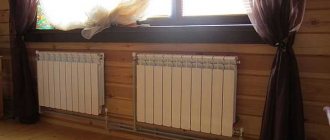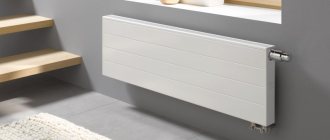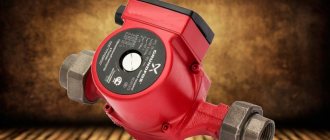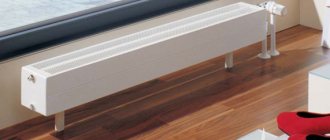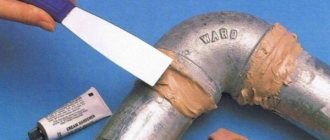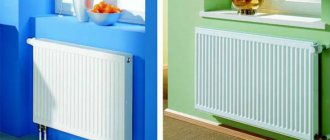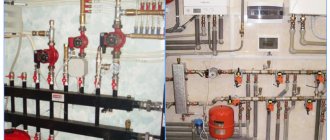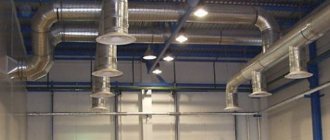A modern heating system for a private home is unthinkable without special shut-off and control valves on batteries. It allows not only to optimize the operation of equipment and extend its service life, but also to significantly reduce energy costs and increase the level of home comfort. Let's consider what taps for heating radiators exist, what their features are and what they are intended for, what requirements are imposed on them and how to select and install them correctly.
Faucet for installation on a heating radiator Source eurosantehnik.ru
Purpose, functions, requirements
During everyday use of the heating system, situations often arise when the supply of coolant to the battery needs to be reduced or stopped altogether. Moreover, in some cases, the presence of a special mechanism that regulates the operating parameters of the equipment is simply necessary and is provided for by the heating device. Therefore, the radiator tap is necessary to maintain the functionality of the system as a whole.
Functions
Radiator taps installed at various points in the circuit allow you to perform the following set of functions:
- De-energize a single section or a specific battery without having to disconnect the entire pipeline. This is very relevant for maintenance, replacement and adjustment procedures.
- Increase or decrease the flow of coolant through the radiator - to regulate the air temperature parameters in the room.
- Protect pipes and devices from possible sudden pressure surges in the network - water hammer.
- Bleed any air pockets that have formed.
- Drain the coolant.
- Control the coolant flow when the bypass is turned off.
- Monitor the level of energy consumption for heating - manually using a thermometer or automatically using thermostat sensors.
Setting up battery parameters Source stoydiz.ru
Note! With the help of radiator taps, you can limit the heat supply or completely shut off those branches of the heating system that are little used or at some times not used at all. This could be a utility room, basement, garage, greenhouse, etc. Special automatic valves cope with this task even more efficiently, as they operate from the settings of temperature sensors. Compared to unregulated heating, they save from 20 to 50% of energy resources.
Requirements
Shut-off and control valves of heating systems operate under rather unusual conditions. It should be more reliable than that used in standard water supply systems. Therefore, taps for radiators must meet the following series of requirements:
- Maintains performance when heated to 200 °C.
- Resistant to internal pressure up to 40 bar.
- High protection of surfaces against corrosion.
- Low sensitivity to mechanical loads.
Direct valve for installation on a radiator Source cloudinary.com
Taking into account the given set of parameters, it is unacceptable to install sliding or shielding type mechanisms in the heating circuit of a private house. The best choice for shut-off valves are ball modifications or valves with a cone gate - for manual adjustment, and valve-cone valves - for automatic control.
Elevator unit
elevator unit of the heating system
If this parameter is lower, it is recommended to use modern plug valves, such as in the photo, since valves have serious disadvantages:
- it is necessary to periodically fill the oil seal, even when the valve is not in use, since the packing, in contact with water, is gradually destroyed;
- After a short period of time, the cheeks begin to become overgrown with deposits. If the valve sits for several years without being used, it will not be possible to close it completely;
- In the event of an emergency, every second can be decisive. If it takes literally a moment to close the plug valve, then it will take a long time to rotate the valve’s steering wheel, even when it is fully operational.
It should be noted that plug valves, which are a ball with a channel for water surrounded by a plastic shell, differ in:
- practicality;
- durability;
- reliable fluid retention;
- no need for maintenance.
They have significant design disadvantages:
Water hammer
Varieties
In modern private houses, the following 4 types of shut-off and control valves are used for radiators:
- Ball overlapping.
- Regulator valves.
- Thermostat valves.
- Air removal mechanisms.
Let us examine in detail their structure, scope of application and operating features.
Ball
Ball valves for heating are classified as shut-off valves. They function only in opposite positions - open or closed. With their help, it is impossible to reduce or increase the coolant flow - but only to completely open or shut off. Therefore, their main area of application is a place where, if necessary, you need to quickly stop the water supply, for example, in front of a battery - when it needs to be replaced or repaired, and also in the event of a leak - the device will quickly shut off the flow.
Ball valve Source aqua-therm.org
See also: Catalog of companies that specialize in engineering systems (heating, water supply, sewerage and others) and related work
The design of the mechanism is based on a steel ball with a through hole. It is connected directly to the handle. In the open position, coolant flows through it. When the handle is turned at a right angle, the spherical element also turns 90 ° and completely stops the flow.
Ball valves are classified according to the following characteristics:
- Type of material. As a rule, the body is made of brass, as well as silumin alloy or plastic.
- Changing the direction of flow - straight and angular.
- Throughput indicator. In its standard form, its value does not exceed 0.8, in full-bore specimens – 1.
- Recommended network pressure parameters.
- Connection method: coupling, welded, flange.
Advice! For connection to radiators in a private house, mainly those with a coupling connection are used. Flange models have a greater safety margin and are suitable for installation on centralized pipelines.
Typical radiator tap Source sopytka.ru
Balancing valves
The heating control valve is equipped with a valve connected to a cone-shaped threaded rod. The smooth movement of the valve ensures a gradual increase or decrease in flow. Using it, it is possible to manually adjust the required flow and pressure in a given section of the heating system. Often such a mechanism is mounted at the outlet of the battery.
The material used for their manufacture is brass or bronze alloy. Budget models are often made from polypropylene. However, it is better to install such taps on pipes of a similar composition. With respect to the direction of flow, they can be either straight or angular. They are used for rough adjustment of the heating level of radiators in various parts of the heating system.
Valves for thermoregulation
An automatic thermostatic valve for a heating radiator is today’s best option for a mechanism for controlling energy consumption in a private heating system. The principle of its operation is based on the compression-expansion of a special gas or liquid in a container connected by a piston to a closing device in the tap.
Tap for automatic control of battery heating Source gopb.ru
Blitz tips
- It is necessary to consider the type of batteries when installing faucets. That is, if the batteries are old and made of cast iron, then there is a high probability of internal corrosion and severe contamination; in general, in this case, it is better to change the batteries, but if this is not possible, then it is better to install a tap that can be easily removed to clean the insides of the radiator.
- It is better to use as much sealing tape as possible for a better seal.
- When purchasing faucets, you need to find out the material from which the device is made in order to avoid purchasing low-quality materials that may not work well in water.
- If you have the opportunity to buy a thermostatic valve , then it is better to purchase it, as it shows high quality and reliability, and most importantly, durability.
- A quick and easily accessible passage must be provided to the tap in order to quickly turn off the water supply during emergencies. That is, you should never crowd the space in front of the battery with various furniture and other things.
Criterias of choice
When deciding which taps are best to install on heating radiators, the following series of criteria must be taken into account:
- Type of heating system, its operating characteristics - temperature, pressure, coolant used and its chemical properties.
- Functionality, purpose, type, properties and quality of the material of the tap itself.
- The method of activation is manually, automatically using sensors and a controller, or semi-automatically.
- Technical parameters of the valves - maximum permissible pressure, operating temperature, etc.
- Corresponding to the diameter of the system pipes.
- Type of connection, thread location (external or internal), pitch.
Reliable manufacturers
A high-quality faucet for a heating system is the key to its long-term operation. When choosing, you must also take into account the manufacturer of the device, since trusted brands will not risk their reputation and produce low-quality products.
First of all, you need to pay attention to the following brands:
- Oventrop (Italy).
- Danfos (Denmark).
- Luxor (Italy).
- Valtek (joint production of Russia and Italy).
Cheaper models are made of silumin. This alloy is quite brittle. For long-term operation of the heating system, it is better not to use these. Instead, quality products are made from brass, steel or bronze.
The world's largest faucet manufacturers use silicone gaskets instead of rubber ones. Silicone does not tend to crack, so such devices last a really long time. Rubber seals lose their elasticity at high temperatures and crumble over time.
Video description
This video shows how to remove air from a radiator using various types of Mayevsky tap:
Using an automatic thermostat as an example, the following general rules for installation exist:
- The tap is selected based on the type of heating system - one- or two-pipe.
- Before installing the device, it is important to reliably determine the direction of movement of the coolant in the system. The arrow on the body of the mounted faucet must correspond to the flow movement.
- The temperature sensor should be placed at right angles to the heated surface in order to remain as independent as possible from a nearby heat source.
- Before supplying coolant, you must ensure the tightness of the adjacent surfaces of the tap and radiator.
- Configuration and adjustment of the temperature sensor should be carried out by checking with an independent room thermometer.
Recommendation! The optimal solution to the problem of energy saving for a private home is an automatic control valve for the heating radiator. Such a device must be mounted on the supply line, while on the return line it is enough to install a standard ball device.
How to disassemble, extend and assemble a heating radiator
Aluminum, bimetallic, cast iron radiators are assembled according to the same principle: sections in the upper and lower parts are connected to each other by nipple nuts. Nipple nuts are hollow, ring-shaped nuts with external threads. The thread is applied to both ends. Special grooves are made inside each one. During assembly and disassembly, a key is inserted into them, rotating which tightens or separates (depending on the direction of rotation) both sections. Sealing is ensured by a gasket made of paronite or silicone, placed on top of the nut.
This is how the radiator is connected to the system
As a rule, it is necessary to disassemble and reassemble heating batteries in the following cases:
- when installing a new heating system;
- if necessary, add additional radiator sections;
- Replace the leaking section or gasket.
You need to change the gasket, which means disassembling the battery and then reassembling it
Briefly about the main thing
Taps on heating radiators perform the following number of tasks:
- De-energize a separate section or battery.
- Reduce or increase coolant flow.
- Protects the system from pressure surges.
- Allows you to drain the coolant.
- Bleeding out the air.
- Save energy resources.
By design, they are divided into ball, valve balancing and thermostatic manual or automatic, as well as air-bleeding. When choosing a faucet, several criteria are taken into account - the type of heating system, the type of device itself and its purpose, technical parameters and compliance with their system, type of connection and method of activation - manually or automatically. Determining its location in the house heating circuit and the installation procedure is best left to a specialist.
Technical features of radiator taps
Valves for heating radiators are valves installed on heating pipes and serving as a shut-off system. Their main feature is to block the access of hot liquid to the battery.
Therefore, if the heating system malfunctions, there is no need to contact the housing and utility company to troubleshoot the problem. When the tap is closed, the water will not flow into the radiator itself, but will pass further along the pipe through the built-in jumper. The radiator will remain without liquid, which will provide conditions for its installation.
- Such devices are ideal for private households.
- If one of the batteries malfunctions, it will be enough to close the valve on it.
- At the same time, other radiators will continue to operate and the temperature in other rooms will not be affected.
Also, this feature of heating taps will help save the family budget; non-residential premises can be turned off from heating by turning off the tap on the radiator.
Work order
To properly replace heating radiators in an apartment, you must:
- Coordinate the modification with the operation service.
- Purchase the necessary materials.
- Perform preliminary assembly of components.
- Prepare tools.
- Agree with the team (if you do not plan to do the work yourself).
- Register the alteration with the Housing Office and decide on the date for the work.
- Remove old radiators.
- Install brackets.
- Hang new batteries.
- Make connections to heating pipes.
- Check the system operation.
During the preliminary assembly of the units, all the necessary elements are installed: plugs, gaskets, Mayevsky taps, etc. In addition, you can mark in advance the places where the pipes will be cut. In this case, you should use a plumb line and level to ensure that the new radiator is level.
If the supply pipes also require replacement, it is necessary to prepare these elements: cut pieces of suitable length, attach tees, etc. All this is done in order to quickly complete the installation after draining the water from the heating system. This measure will be more than relevant if the need to replace old batteries arises during the heating season.
Welding is used to replace metal pipes. The edges of the structures will need to be threaded to securely connect them to the radiator
The procedure for removing old batteries depends on whether the pipes also need to be replaced. If the supply lines need to be preserved, you will have to carefully unscrew the old battery
At the same time, it is important to maintain the squeegee - a sufficiently long thread on the edge of the pipe. The radiator is fixed with a nut and coupling, which will have to be unscrewed
The procedure can be quite complicated. If the parts do not budge, you can try to loosen the connection using anti-corrosion compounds. In the most extreme case, the radiator is simply cut off with a grinder. There should be at least 10mm of thread left. Burrs should be removed from it.
If you decide to leave the old steel pipes, then dismantling the radiator must be carried out carefully so that the threads on the pipes remain intactIf it was not possible to maintain the flow, you will have to extend the pipes and also cut new threads. The removed locknuts can later be reused when installing a new radiator. It is much easier to dismantle the radiator if the pipes are also replaced. In this case, they are simply cut off in a suitable place. This is usually where the system turns toward its neighbors above and below.
Now you need to install the brackets and then hang the new radiator on them. At this stage, it is sometimes necessary to adjust the length of the supply pipe. All that remains is to restore the threaded connection
It is very important to perform the compaction correctly. For this, flax or plumbing thread is usually used.
Some craftsmen do not recommend using FUM tape on such connections. The seal is wound clockwise so that it forms a cone growing from the edge of the thread. Then screw on the connecting nut. If some of the seal remains outside, this is normal. But its layer should not be too thick.
Such work generates a lot of waste. They are best done during major renovations, after the windows are installed.
To achieve maximum tightness, sometimes the seal is impregnated with paint, after which the lock nut is screwed on. Then the protruding insulation is also impregnated with paint. A water-based composition is not suitable for these purposes. Once the paint has dried, it is very difficult to unscrew the connection.
Once the connection is complete, remove the protective film from the radiator. It is also necessary to check the position of the air vent. Its hole should be directed upwards. To check the quality of work, you need to ask plumbers to pump water into the heating circuit under pressure.
It is better to remove the film in which the new radiator is packaged after it is installed, so as not to accidentally damage the coating
This will allow leaks to be identified and repaired immediately. During operation, it does not hurt to observe the radiator for the first time, and also check the condition of the connections to make sure that they are not leaking.
What kind of piping can be made from polypropylene pipes
The piping for a home heating system can be very different. The thing is that the consumer is always trying to reduce the amount of consumables, while simultaneously trying to install radiators in all heated rooms.
It should be said right away that these are relics of the past. Unlike expensive metal pipes, polypropylene consumables are much cheaper and easier to install. therefore, it is not worth saving on the length of the pipeline. Choose the type of harness that will bring maximum benefit in your case. The only reasons that may influence the choice of type of harness are the following factors:
- what heating circuit is used (one-pipe system or two-pipe);
- what type of radiator connection you have chosen (diagonal, side or bottom).
As a rule, when using any heating scheme: single-pipe or two-pipe, you can use any type of heating radiator connection.
According to experts, pipeline laying must minimize the number of bends. A smooth highway remains resistant to hydrodynamic loads. The number of zones in which air can accumulate will be reduced in the pipeline.
There are specific features for piping a single-circuit and double-circuit heating system using polypropylene pipes.
- Typically, such a system uses a series connection of radiators;
- A bypass is always installed in front of the battery, connecting the supply pipe and return pipe. During normal operation of the heating system, the bypass is not activated. When carrying out maintenance work or in the event of an emergency, the water supply to the radiator is stopped. The coolant circulates freely through the bypass.
- Both parallel and serial connections of batteries are used;
- Both radiator hoses are connected to different pipes. The upper one is connected to the supply pipe, the lower pipe is connected to the return pipe. Typically, radiators are connected in parallel in two pipe systems, so installing bypasses is not required.
Tying polypropylene pipes with radiators is done in two ways: soldering and using fittings. Radiators are installed and connected using a soldering iron and American-style plumbing wrenches.
